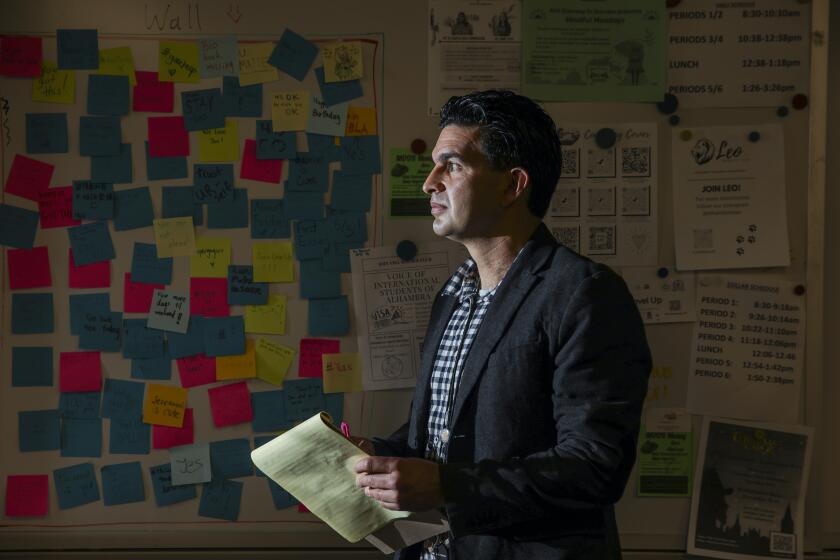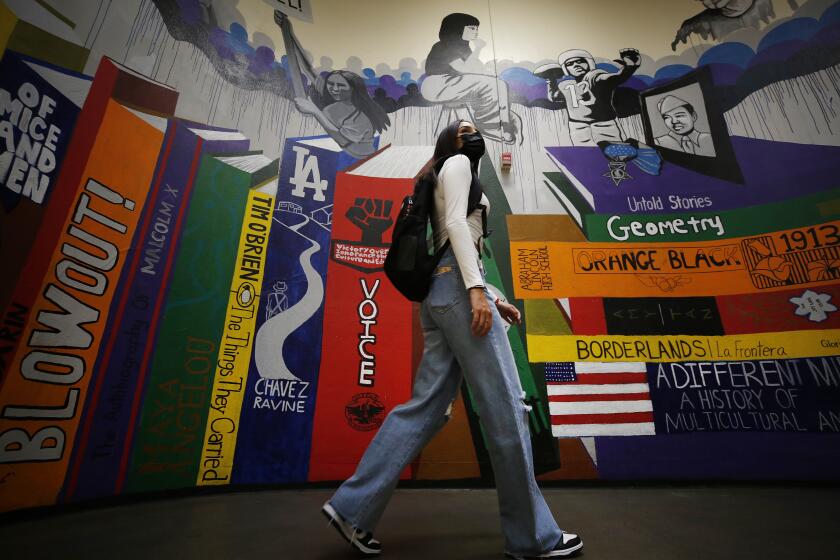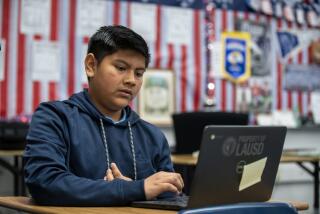Tutoring, a key learning recovery strategy, reaches fewer than 1 in 10 L.A. students

- Share via
Tutoring, considered a cornerstone to academic recovery from the pandemic, has reached fewer than 1 in 10 Los Angeles students, a sign of continuing challenges in efforts to help students in the nation’s second-largest school system.
The latest data, presented to the Board of Education on Tuesday, show that a higher percentage of students in elementary school receive tutoring. In grades 1 through 5, tutors work with about 11% of students.
In middle and high schools the numbers who have worked with tutors drop substantially, ranging from about 4% to about 6%, depending on the grade. In all, about 36,368 students have worked with tutors. The presentation did not provide information about when the tutoring took place or for how long. Some tutoring was in person; some online. And the effort at 29 schools was described as “24-hour real-time support for Grades 6-12.”
Tutoring represents just one way to accelerate learning, but the figures were a cause for concern among local officials. Tutoring has been singled out as a central pandemic response by the state’s most senior public officials, including state Supt. of Public Instruction Tony Thurmond, state Board of Education President Linda Darling-Hammond and Gov. Gavin Newsom, who alluded to funding for “high-dose tutoring” as an important element of the state’s expanded education budget.
States and school districts across the country have ramped up tutoring in myriad forms, trying to provide the same benefit as pricey private firms. Online services can connect students to tutors scattered across the country, older students are being paid to tutor younger siblings, volunteers are signing up and for-profits have expanded.
Effective tutoring — one on one or in small groups — is “one of the most versatile and potentially transformative educational tools in use today,” concluded researchers from Northwestern University, University of Toronto and Poverty Action Lab in Cambridge, Mass.
L.A. school board member Jackie Goldberg and other board members clearly had that context in mind.
“One of the things that we are learning nationwide,” Goldberg said at the meeting, “is that some of the ways that we’re making up lost learning is through extra tutoring. And that’s why I have to say I was stunned to see so few students.” She acknowledged “there are other things going on” but “I’m anxious to know how we increase this dramatically. And whether or not we have ... enough resources to increase it dramatically. Because if we don’t, that’s something we need to know.”
Pandemic-forced school closures revealed how grade-point systems hurt disadvantaged children, prompting educators to look for ways to bring equity to grading.
In the near future, thanks to one-time COVID-relief aid and record state tax revenue, money for tutoring should not be a problem. Goldberg asked why the numbers were so low.
Carlen Powell, administrator of elementary instruction, did not have a clear answer. It could be, she suggested, the number is higher but schools have not yet updated the data on all of those receiving help.
The presentation listed five tutoring programs — three for elementary grades, where there was outreach to recruit participants, and two for higher grade levels, for which students typically enlisted themselves or “self-referred,” as staff put it.
The presentation and responses did not ease Goldberg’s concerns.
“Those numbers seem incredibly low to me,” she reiterated. “If they can self-refer — and if mom or dad can call, I just don’t see how we have so few students in this. How do we know that students who need it most are ... getting tutoring?”
Board member Tanya Ortiz Franklin wanted to know how much actual tutoring figured into this data. Did one 30-minute session mean that the district counted a student as having received tutoring?
Powell pledged to research the answers. She noted that tutoring efforts are managed locally.
L.A. schools Supt. Alberto Carvalho, who began work in February, said that the data available were inconsistent and inadequate in this area and others — and a major problem that he intended to address.
The tutoring update was one portion of a presentation that showed progress in filling teacher and other vacancies, although still falling short of goals.
More than half the new teachers hired are not fully credentialed, according to the data presented, despite $5,000 hiring bonuses for 607 who were credentialed. Officials did not provide information on how many teaching vacancies remain, but there are many. For example, in the Primary Promise program, which provides extra teachers to the lowest-achieving elementary schools, 105 of 229 math teacher positions budgeted for this year have been filled.
The district also remains significantly short of professionals to provide mental health services. For example, the district has hired 250 of the budgeted 1,029 psychiatric social workers.
Other school systems face similar staffing shortages. L.A Unified has been developing plans to bring in outside professionals to cover for vacant staff mental health positions.
Pedro Noguera, dean of USC’s Rossier School of Education, pointed to Primary Promise as a bright spot. The program is expensive, but early data are promising.
“The strategy they have outlined is on target,” said Noguera, whose university will evaluate L.A. Unified academic efforts. “The primary challenge will be recruiting and training a sufficient number of tutors/instructional aides so that the program can expand to serve more kids in more schools. This won’t be easy, but the evidence is clear that if they expand this initiative, it will lead to significant gains in student outcomes.”
It could be that L.A. Unified’s tutoring participation rate is somewhat in line with other school systems. A state-run program in Tennessee that has received praise hopes to reach 15% of students in that state by the end of the academic year.
District data suggest an intense need for academic support. And research from around the country suggests that Latino and Black students from low-income families slipped more academically during the pandemic. These students, especially Latinos, make up the vast majority in L.A. Unified.
A Los Angeles Times analysis of data offers an alarming assessment of the impact of the pandemic on L.A. students.
UC Berkeley education professor Bruce Fuller said the district’s data suggest the factor most helping students recover academically is the return to in-person education — after a year of campus closures that began at the outset of the pandemic, in March 2020. Compared with that reset, tutoring may be a side issue.
“What’s the value-added of tutoring beyond the bounceback of kids returning to in-person school?” Fuller said.
The best focus, he said, might be on optimizing the classroom experience: “Federal stimulus dollars will disappear in 2024. It’s so urgent to recover kids’ lost learning. Still, does tacking on tutoring dodge the key question of how to attract and lift teachers who better motivate learning inside regular classrooms?”
Fuller and Noguera recently co-wrote an article laying out numerous steps L.A. Unified could take to improve academic achievement.
L.A. school board President Kelly Gonez said she wants to get beyond participation numbers.
“It’s not just about: Is tutoring being offered, but is it high-dosage and high-quality tutoring? And I’d love to see, for the students who are being served, what are the outcomes — like, are they making progress? Because it’s not just about the provision of the resource, but really, is it impacting their learning in a positive way?”
More to Read
Sign up for Essential California
The most important California stories and recommendations in your inbox every morning.
You may occasionally receive promotional content from the Los Angeles Times.














